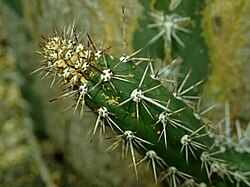Biology:Harrisia tortuosa
| Harrisia tortuosa | |
|---|---|

| |
| Scientific classification | |
| Kingdom: | Plantae |
| Clade: | Tracheophytes |
| Clade: | Angiosperms |
| Clade: | Eudicots |
| Order: | Caryophyllales |
| Family: | Cactaceae |
| Subfamily: | Cactoideae |
| Genus: | Harrisia |
| Species: | H. tortuosa
|
| Binomial name | |
| Harrisia tortuosa (J. Forbes ex Otto & A. Dietr.) Britton & Rose
| |
Harrisia tortuosa is a species of cactus in the Trichocereeae tribe.[2]
Description
Harrisia tortuosa grows as a shrub with upright or later arched or prostrate, dark green shoots that are up to 1 meter long with diameters of 2 to 4 centimeters. There are usually seven rounded, slightly tuberous ribs. The one to three strong central thorns, initially red, later become almost black. They are 3 to 4 centimeters long. The six to ten pale and light-colored marginal spines reach a length of up to 2 centimeters.
The flowers reach a length of up to 16 centimeters. The spherical, bumpy red fruits have a few thorns and reach a diameter of 3 to 4 centimeters.[3]
Distribution
It is native to low altitudes in Uruguay, Paraguay, northeastern Argentina at elevations of 80-300 meters.[4]
Harrisia tortuosa is considered an exotic invasive in Australia .[2][5]
Taxonomy
The first description as Cereus tortuosus was made in 1838 by Christoph Friedrich Otto and Albert Gottfried Dietrich.[6] The specific epithet tortuosa means 'tortuous, abundant with coils'. Nathaniel Lord Britton and Joseph Nelson Rose placed the species in the genus Harrisia in 1920. Another nomenclature synonym is Eriocereus tortuosus (J.Forbes ex Otto & A.Dietr.) Riccob. (1909).[7]
References
- ↑ Oakley, L.; Pin, A. (2017). "Harrisia tortuosa". IUCN Red List of Threatened Species 2017: e.T152724A121546299. doi:10.2305/IUCN.UK.2017-3.RLTS.T152724A121546299.en. https://www.iucnredlist.org/species/152724/121546299. Retrieved 25 November 2022.
- ↑ 2.0 2.1 "Harrisia cactus". The State of Queensland, Department of Agriculture, Fisheries and Forestry. 2013. https://www.daf.qld.gov.au/__data/assets/pdf_file/0003/49179/IPA-Harrisia-Cactus-PP22.pdf.
- ↑ Anderson, Edward F.; Eggli, Urs (2005) (in de). Das grosse Kakteen-Lexikon. Stuttgart (Hohenheim): Ulmer. p. 341. ISBN 3-8001-4573-1.
- ↑ Franck, Alan R. (2016). "MONOGRAPH OF HARRISIA". Phytoneuron. http://www.phytoneuron.net/2016Phytoneuron/85PhytoN-HarrisiaPt1.pdf.
- ↑ "Prohibited invasive plants: Harrisia cactus". Queensland Government. 1 January 2016. https://www.business.qld.gov.au/industries/farms-fishing-forestry/agriculture/land-management/health-pests-weeds-diseases/weeds-diseases/prohibited/harrisia-cactus.
- ↑ Forbes, J. (1837). Journal of a horticultural tour through Germany, Belgium, and part of France, in the autumn of 1835. To which is added, A catalogue of the different species of cacteæ in the gardens at Woburn abbey. J. Ridgway & Sons. p. 154. https://books.google.com/books?id=z3gDAAAAYAAJ&pg=PA154. Retrieved 2023-10-12.
- ↑ Britton, Nathaniel Lord; Eaton, Mary E.; Rose, J. N.; Wood, Helen Adelaide (1919). The Cactaceae : descriptions and illustrations of plants of the cactus family. Washington: Carnegie Institution of Washington. doi:10.5962/bhl.title.46288.
External links
Wikidata ☰ Q1586242 entry
 |


